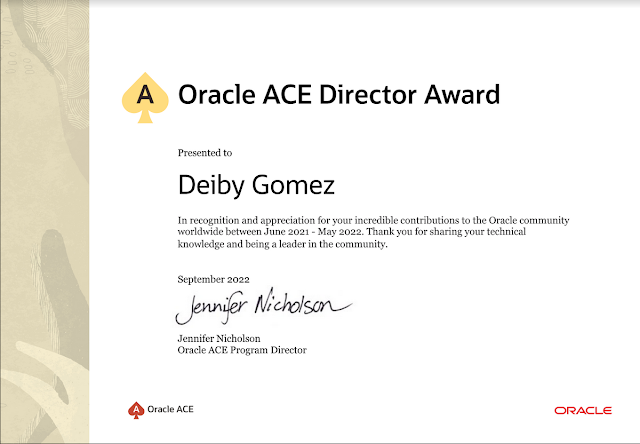El escenario es el siguiente:
- Windows Server 2012 R2 (hostname ORCL-SRV01)
- Oracle Database EE 12c (db_name ORCL)
- Oracle Cloud Object Storage (Bucket name ORCL)
El primer paso consiste en crear nuestro “Bucket” para el almacenamiento de los archivos de backup. En un articulo anterior aprendimos como crear este objeto.
Para este ejercicio usaremos el bucket creado anteriormente con nombre ORCL y los siguientes datos:
Para este ejercicio usaremos el bucket creado anteriormente con nombre ORCL y los siguientes datos:
Una vez creado nuestro bucket procederemos a configurar los accesos desde el servidor hacia nuestro objeto.
Configurando los API KEYS
Para Windows podemos usar cualquier software de emulador de línea de comandos, para este ejercicio utilizamos Git Bash para Windows.
Una vez instalado el software generamos nuestras llaves de la siguiente manera:
Cuando hayamos generado nuestras llaves, el siguiente paso es registrarlas dentro de nuestra configuración de Oracle Cloud, además extraeremos los OCID (Oracle Cloud ID) de los objetos que necesitamos para enviar nuestro backup.
Seleccionamos la opción Profile en la esquina superior derecha y presionamos sobre el menú User Settings:
Para Windows podemos usar cualquier software de emulador de línea de comandos, para este ejercicio utilizamos Git Bash para Windows.
Una vez instalado el software generamos nuestras llaves de la siguiente manera:
winpty openssl genrsa -out ORCL-SRV01_oci_api_key.pem 2048
winpty openssl rsa -pubout -in ORCL-SRV01_oci_api_key.pem -out FR-ORCL-TEST-02_oci_api_key_public.pem
Cuando hayamos generado nuestras llaves, el siguiente paso es registrarlas dentro de nuestra configuración de Oracle Cloud, además extraeremos los OCID (Oracle Cloud ID) de los objetos que necesitamos para enviar nuestro backup.
Seleccionamos la opción Profile en la esquina superior derecha y presionamos sobre el menú User Settings:

Dentro del usuario, presionamos el botón Add Public Key y en el pantalla enerada copiamos y pegamos la llave publica generada antes y que enviamos al archivo public.pem
Una vez hecho esto, debemos tomar nota de los siguientes datos:
- OCID del usuario rman-service
- Fingerprint generado después de añadir la public key
- OCID del usuario
- Fingerprint del usuario
- OCID del tenant
Instalando Oracle Database Cloud Backup Module for OCI en Windows
Para este paso de la configuración necesitaremos:
- Instalar JAVA JDK en nuestro servidor Windows, el instalado esta disponible en las descargas de Oracle.
- Descargar y descomprimir el paquete Oracle Database Cloud Backup Module for OCI desde http://www.oracle.com/technetwork/database/availability/oracle-cloud-backup-2162729.html
java -jar oci_install.jar -host https://objectstorage. eu-frankfurt-1.oraclecloud.com -pvtKeyFile D:\keys\OCI\APIKEY\ ORCL-01_oci_api_key.pem ^
-pubFingerPrint 25:a4:fa:98:19:e1:49:2c:64:a7:56:88:53:85:67:46 ^
-uOCID ocid1.user.oc1..aaaaaaaakukwjzadgha22j2hqyp7xw66stbnusjjol7suevp7msa ^
-tOCID ocid1.tenancy.oc1..aaaaaaaa4oeek44i4wef5kuqzcluxwucjyirkuljnss5a ^
-walletDir D:\app\oracle\product\12.0.0\database\opc_wallet ^
-libDir D:\app\oracle\product\12.0.0\database\lib ^
-bucket ORCL
-configFile D:\app\oracle\product\12.0.0\db\config.oraLos parámetros son los siguientes:
- Host: la url del bucket, dependerá de la región donde este configurado nuestro tenant de Oracle cloud.
- pubFingerPrint: dato que tomamos del usuario rman-service
- uOCID: OCID del usuario rman-service
- tOCID: OCID de nuestro tenant
- walletDIR: directorio donde se creara un wallet automático que almacenara la configuración de seguridad para el acceso al bucket.
- libDir: directorio donde se descargara la librería libopc.so o libopc.dll necesaria para establecer la conexión desde RMAN.
- Bucket: nombre de nuestro bucket.
- configFile: archivo de configuración con los datos de las rutas de wallet y librería descargada.
La salida de este comando debería ser, sin errores:
Configurando RMAN
Nota: el backup de RMAN no ira directo al bucket en la nube, debe pasar antes por un almacenamiento físico dentro de nuestro servidor, una vez allí podemos generar backups de los backupsets antes creados.
Ya estamos por finalizar, el primer paso será cambiar la configuración de RMAN como sigue.
rman target /
CONFIGURE CHANNEL DEVICE TYPE 'SBT_TAPE' PARMS 'SBT_LIBRARY= D:\app\oracle\product\12.0.0\database\lib\libopc.dll, SBT_PARMS=(OPC_PFILE= D:\app\oracle\product\12.0.0\db\config.ora)';
CONFIGURE BACKUP OPTIMIZATION ON;
CONFIGURE CONTROLFILE AUTOBACKUP ON;
CONFIGURE CONTROLFILE AUTOBACKUP FORMAT FOR DEVICE TYPE SBT_TAPE TO '%F';
CONFIGURE ENCRYPTION FOR DATABASE ON;Una buena practica es crear nuestros backups de manera encriptada, aunque no es un paso necesario, recordemos que por default los datos dentro de un Object Storage son encriptados.
El primer paso será crear un backup hacia un almacenamiento físico dentro de nuestro servidor:
rman target /
SET ENCRYPTION ON IDENTIFIED BY "dsk45opT4dihg_0f_XXXXXXds7" ONLY;
BACKUP INCREMENTAL LEVEL 0 DATABASE PLUS ARCHIVELOG;
BACKUP INCREMENTAL LEVEL 1 DATABASE PLUS ARCHIVELOG;
rman target /
set encryption ON identified by "dsk45opT4dihg_0f_XXXXXXds7" Only;
run {
allocate channel sbt1 device type sbt PARMS 'SBT_LIBRARY= D:\app\oracle\product\12.0.0\database\lib\libopc.dll, SBT_PARMS=(OPC_PFILE= D:\app\oracle\product\12.0.0\db\config.ora)';
backup backupset completed after 'sysdate-1';
}

















